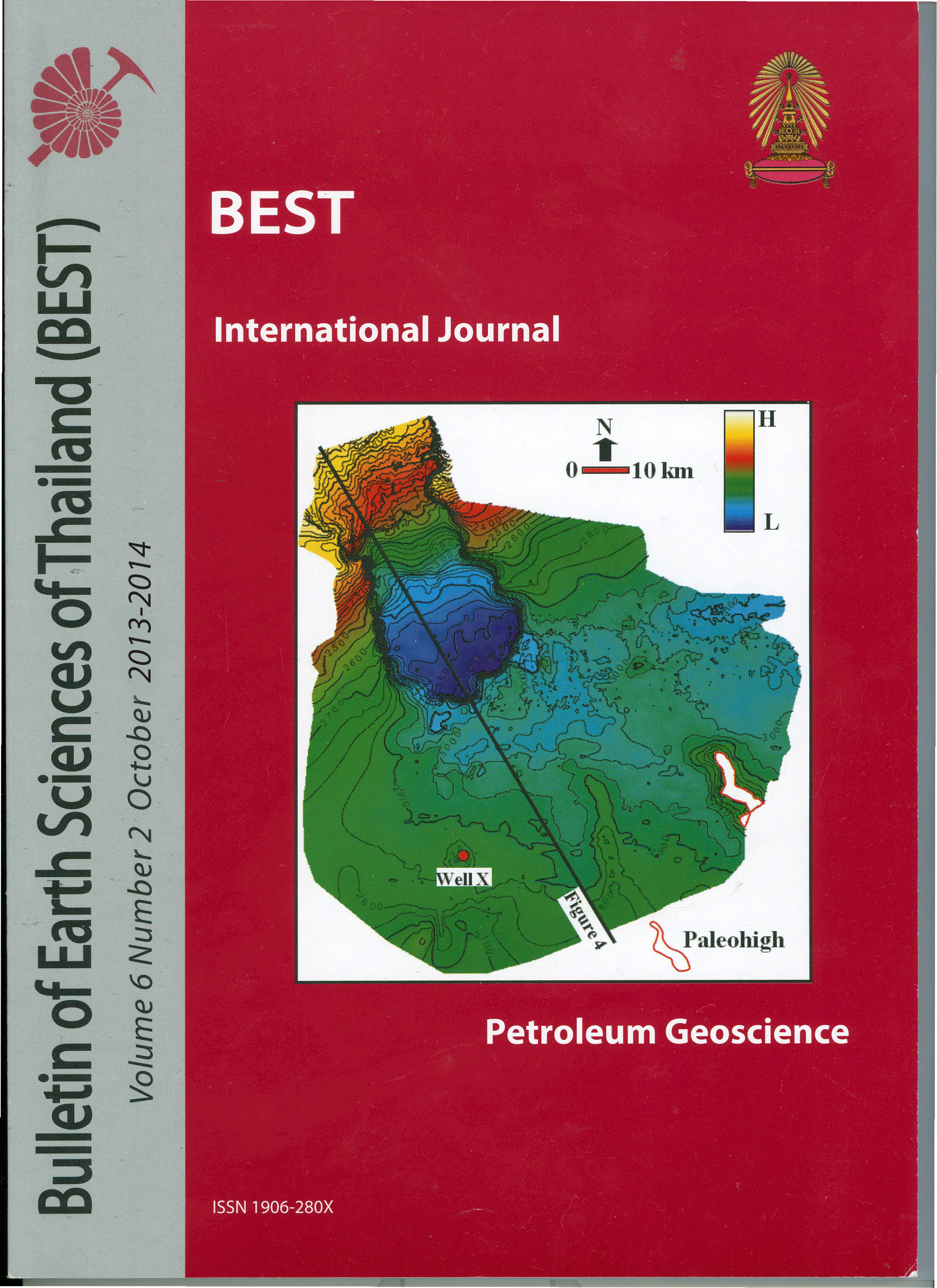Study of a Mass Transport Complex, South Makassar Strait Basin Indonesia
Main Article Content
Abstract
The South Makassar Strait Basin Mass Transport Complex (SMSB MTC) covers an area of at least 9000 km2 and with a total volume of 2438 km3
. It is composed of a shale dominated sedimentary unit with high water content. The SMSB MTC differs from other very large MTC’s in displaying relatively coherent internal sedimentary stratigraphy, and is probably the largest know coherent MTC or slump. It has a central region up to 1.7 kms thick which forms a bowl-shape confined by two NW-SE trending steep lateral ramps in the upper slope area and a NE-SW trending frontal ramp area. The MTC anatomy can be divided into an extension headwall,
translational, toe, flank, lateral apron and frontal apron domains. It is interpreted to be triggered by SMSB accelerated subsidence in the Pliocene and slid along a weak basal detachment that lies at the interface between two sedimentary units of different lithologies which was probably overpressured due to fluid migration events. The internal fault patterns of the MTC show that its movement in the upper slope to the middle part of the bowl area is extensional which changes to compressional in the
toe domain and apron. Later extensional collapse of parts of the compressional toe area occurred with negative inversion on some faults. The coherent internal stratigraphy suggests the MTC deformed at a slow strain rate, perhaps in the order of cms/yr over thousands of years. Hence this type of MTC does not have the potential to generate tsunamis but could affect deepwater facilities built on the active MTC.
Article Details

This work is licensed under a Creative Commons Attribution-NonCommercial-NoDerivatives 4.0 International License.
Copyright © 2008 Department of Geology, Faculty of Science, Chulalongkorn University. Parts of an article can be photocopied or reproduced without prior written permission from the author(s), but due acknowledgments should be stated or cited accordingly.
References
Armandita, C., Pudyo, N., Saputra, S. E., and Sumaryana, 2010, Exploration challenges and opportubities in deepwater Makassar Strait Basin, Indonesia: review of carbonate play based on sequence stratigraphy and seismic characterization: Society of Exploration Geophysicists International Exposition and 81st Annual Meeting, 4 p.
Bachtiar, A., Purnama, Y. S., Suandhi, P.A., Krisyunianto, A., Rozalli, M., Nugroho, D. H. H. and Suleiman, A., 2013. The Tertiary palaeogeography of the Kutai Basin and its unexplored hydrocarbon plays: Proceedings of the Indonesian Petroleum Association, 37th Annual Convention and Exhibition IPA13-G-126, 37 p.
Canals, M., Lastras, G., Urgeles, R., Casamor, J. L., Mienert, J., Cattaneo, A., De Batist, M., Haflidason, H., Imbo, Y., Laberg, J. S., Locat, J., Long, D., Longva, O., Masson, D. G., Sultan, N., Trincardi, F., and Bryn, P., Slope failure dynamics and impacts from seafloor and shallow sub-seafloor geophysical data: case studies from the COSTA project: Marine Geology, 213, p. 9-72.
Dade, W.B., Huppert, H.E., 1998. Longrunout rockfalls. Geology 26,803–806.
Davis, G. H., and Reynolds, S. J., Structural geology of rocks and region, 2nd edition, 1996, John Wiley and Sons, Inc, 776 p.
Dykstra, M., Garyfalou, K., Kertznus, V., Kneller, B., Milana, J. P., Molinaro, M., Szuman, M., and Thompson, P., 2011, Mass-Transport deposits: combining outcrop studies and seismic forward modeling to understand lithofacies distributions, deformation, and their seismic stratigraphic expression: SEPM (Society for Sedimentary Geology) Special Publication 96, p. 293-310.
Gee, M. J. R., Uy, H.S., Warren, J. K., Morley, C. K., and Lambiase, J. J., The Brunei slide: A giant submarine landslide on the North West Borneo margin revealed by 3D seismic data: Marine Geology 246, p. 9-23.
Gue, C. S., 2012, Submarine landslide flows simulation through centrifuge modeling: unpublished Ph.D. thesis, University of Cambridge, UK, 231 p.
Haflidason, H., Sejrup, H. P., Nygård, A., Mienert, J., Bryn, P., Lien, R., Forsberg, C. F., Berg, K., and Mason, D., 2004, The Storegga slide: archithecture, geometry and slide development: Marine Geology 213, p. 201-234.
Kupecz, J., Sayers, I., Tognini, P., Hilman, A., Tanos, C. and Ariyono, D., 2013. New insights into the tectono-stratigraphic evolution of the South Makassar Basin: Proceedings, Indonesian Petroleum Association, 37th Annual Convention and Exhibition, IPA13-G-158, 30 p.
Morgan, J. K., Moore, G. F., and Clague, D. A., 2003, Slope failure and volcanic spreading along the submarine south flank of Kilauea volcano, Hawaii: Journal of Geophysical Research, v. 108, no. B9, 2415, 24 p.
Pireno, G. E., and Darussalam, D. N., 2010, Petroleum system overview of the Sebuku Block and the surrounding area: potential as a new oil and gas province in South Makassar Basin, Makassar Strait: Proceedings Indonesian Petroleum Association, 34th Annual Convention and Exhibition, IPA10-G-169, 16 p.
Posamentier, H.W., and Martinsen O. J., 2011,The character and genesis of submarine mass-transport deposits: Insight from outcrop and 3D seismic data: SEPM (Society for Sedimentary Geology) Special Publication 96, p. 7-38.
Satyana, A. H., 2010, Crustal of the eastern Sundaland’s rifts, Central Indonesia: geophysical constraints and petroleum implications: Proceedings of The Bali International Geosciences and Exposition, 10 p.
Tanos, C. A., Kupecz, J., Lestari, S., Warren, J. K., and Baki, A., 2012, Depositional and diagenetic effects onreservoir properties in carbonate debris deposits: comparison of two debris flow within the Berai Formation, Makassar Strait, Indonesia: Presentation slides in American Association of Petroleum Geologists International Convention and Exhibition, 29 p


